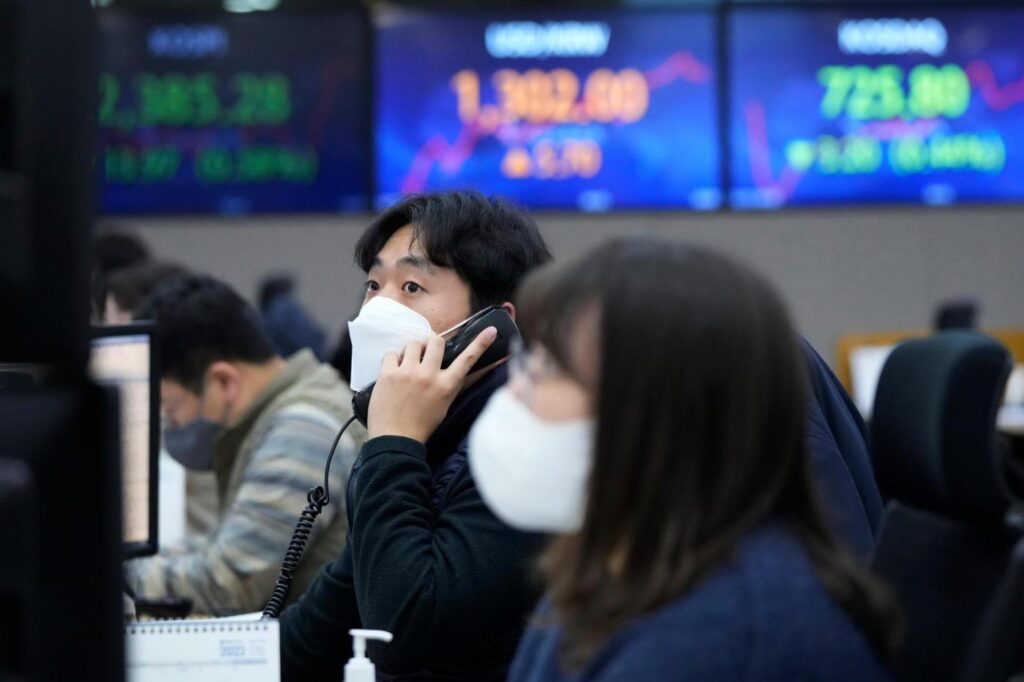
By DAMIAN J. TROISE and ALEX VEIGA (AP Business Writers)
Stocks fell broadly on Wall Street Thursday following the latest signal from the Federal Reserve that interest rates will need to go higher than previously expected in order to tame inflation.
The S&P 500 fell 2.8% as of 2:16 p.m. Eastern, with roughly 95% of stocks in the benchmark index in the red. The Dow Jones Industrial Average fell 901 points, or 2.7%, to 33,064 and the Nasdaq fell 3.4%. The slide erased all the weekly gains for the major indexes.
Technology and communication services stocks led the market’s sell-off. Microsoft fell 3.5% and Google parent Alphabet was down 5.1%.
Treasury yields mostly fell, reflecting increased worries on Wall Street that the economy is unlikely to avoid a recession as the Fed continues raising interest rates.
“The (stock) market’s reaction is now factoring in a recession, and rejecting the possibility of the ‘soft/softish’ landing” that Fed Chair Jerome Powell raised in a speech last month, said Quincy Krosby, chief global strategist for LPL Financial.
The Fed raised its short-term interest rate by half a percentage point on Wednesday, its seventh increase this year. Central banks in Europe followed along Thursday, with the European Central Bank, Bank of England and Swiss National Bank each raising their main lending rate by a half-point Thursday. European stocks fell sharply, with Germany’s DAX dropping 3.3%.
Although the Fed is slowing the pace of its rate increases, the central bank signaled it expects rates to be higher over the coming few years than it had previously anticipated. That disappointed investors who hoped recent signs that inflation is easing somewhat would persuade the Fed to take some pressure off the brakes it’s applying to the U.S. economy.
The federal funds rate stands at a range of 4.25% to 4.5%, the highest level in 15 years. Fed policymakers forecast that the central bank’s rate will reach a range of 5% to 5.25% by the end of 2023. Their forecast doesn’t call for a rate cut before 2024.
The yield on the two-year Treasury, which closely tracks expectations for Fed moves, rose to 4.24% from 4.21% late Wednesday. The yield on the 10-year Treasury, which influences mortgage rates, slipped to 3.43% from 3.48%.
The three-month Treasury yield slipped to 4.33%, but remains above that of the 10-year Treasury. That’s known as an inversion and considered a strong warning that the economy could be headed for a recession.
“The yield curve inversions continue to shout recession,” Krosby said.
The central bank has been fighting to lower inflation at the same time that pockets of the economy, including employment and consumer spending, remain strong. That has made it more difficult to rein in high prices on everything from food to clothing.
On Thursday, the government reported that the number of Americans applying for unemployment benefits fell last week, a sign that the labor market remains strong. The U.S. did report that retail sales fell in November as inflation squeezes wallets. That pullback followed a sharp rise in spending in October.
Like the Fed, central bank officials in Europe said inflation is not yet corralled and that more rate hikes are coming.
“We are in for a long game,” European Central Bank President Christine Lagarde said at a news conference.
Markets in Asia slipped. The Asian Development Bank downgraded its forecasts for developing economies in Asia, putting growth for the region at 4.2% this year and 4.6% in 2023. The earlier forecasts had put 2022 growth at 4.3% and 2023′s expansion at 4.9%.
—
Elaine Kurtenbach and Matt Ott contributed to this report.
